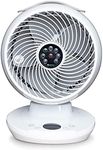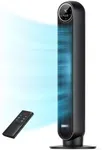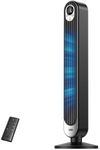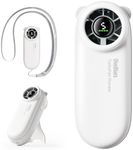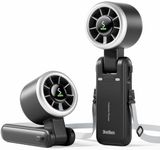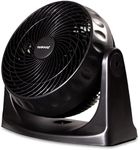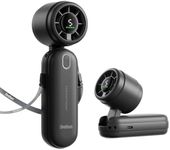Buying Guide for the Best Silent Fans
Choosing the right silent fan can significantly improve your comfort and productivity, whether you're using it in your home, office, or any other space. Silent fans are designed to provide effective cooling while minimizing noise, making them ideal for environments where peace and quiet are essential. To find the best silent fan for your needs, it's important to understand the key specifications and how they impact performance and usability. Here are the main factors to consider when selecting a silent fan.Noise LevelNoise level is measured in decibels (dB) and indicates how loud the fan will be when in operation. This is crucial for ensuring a quiet environment. Fans with noise levels below 30 dB are considered very quiet and are suitable for bedrooms or offices. Fans with noise levels between 30-50 dB are moderately quiet and can be used in living rooms or kitchens. If you need a fan for a very quiet space, aim for the lowest possible noise level.
AirflowAirflow is measured in cubic feet per minute (CFM) and indicates how much air the fan can move. This is important for determining the fan's cooling effectiveness. Fans with lower CFM (under 100) are suitable for small rooms or personal use. Medium CFM (100-300) fans are good for average-sized rooms, while high CFM (over 300) fans are ideal for large spaces or areas with poor ventilation. Choose a fan with an airflow rating that matches the size of the space you need to cool.
Fan SizeFan size refers to the diameter of the fan blades and affects both airflow and noise. Larger fans (over 16 inches) can move more air and are generally quieter at lower speeds, making them suitable for larger rooms. Medium-sized fans (10-16 inches) offer a balance between airflow and noise, ideal for average-sized rooms. Smaller fans (under 10 inches) are portable and best for personal use or small spaces. Select a fan size based on the room size and your portability needs.
Speed SettingsSpeed settings allow you to adjust the fan's airflow and noise level. This is important for customizing comfort and noise levels. Fans with multiple speed settings (usually 3-5) offer more flexibility, allowing you to choose a lower, quieter setting for nighttime use or a higher setting for maximum cooling during the day. Consider how much control you want over the fan's performance and choose a model with the appropriate number of speed settings.
OscillationOscillation refers to the fan's ability to rotate from side to side, distributing air more evenly throughout the room. This is important for ensuring consistent cooling. Fans with oscillation features can cover a wider area, making them suitable for larger rooms or spaces with multiple occupants. If you need to cool a specific area or prefer a stationary airflow, a non-oscillating fan may be sufficient. Decide based on the room layout and your cooling needs.
Energy EfficiencyEnergy efficiency indicates how much power the fan consumes relative to its cooling performance. This is important for reducing electricity costs and environmental impact. Look for fans with energy-efficient ratings or features like DC motors, which use less power than traditional AC motors. If you plan to use the fan frequently or for extended periods, an energy-efficient model can save you money in the long run. Choose based on your usage patterns and energy-saving goals.
Additional FeaturesAdditional features can enhance the fan's usability and convenience. These may include remote controls, timers, sleep modes, or air purification functions. While not essential, these features can provide added comfort and ease of use. Consider which additional features would be most beneficial for your lifestyle and preferences. For example, a remote control can be handy for adjusting settings from a distance, while a timer can help you save energy by automatically turning off the fan.
